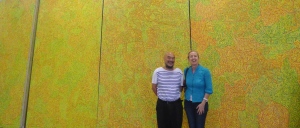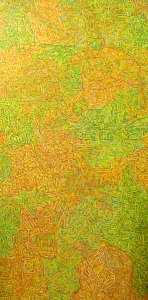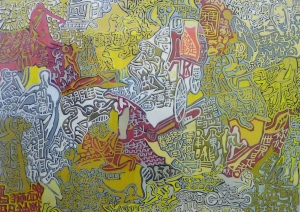Yi Ling Studio Visit
A few weeks ago I had the wonderful opportunity to visit the studio of Yi Ling in SongZhuang. He is also known as the bearded head of YuanMingYuan days (Old Summer Palace) because if his willingness to help new artists settle in.
Yuan Ming Yuan was the first artist village to emerge in the late ‘80s on the north west of Beijing located near the ruins of the old Summer Palace. The 80’s brought the beginning of reforms which opened the door to a whole new era and artists were ready to embrace this. Hundreds of painters, poets and rock musicians flocked to YuanMingYuan bringing a burst of intense artistic exploration and experimental art. As it was considered far too radical and too close in proximity to the Universities and was removed in the mid 90’s and artists relocated to new villages such as Songzhuang.
Once you enter the huge space of Yi Lings two long walls are filled with five layers deep of huge canvasses laid side by side, each canvas co joined by the imagery on the edges in the dialect that is specifically Yi Ling’s. The imagery in the bold outlines of folk art, a wild dance of geometric designs and calligraphy until his canvas is an intricate maze of line and colour in which the figures are barely distinguised. It is the quest for balance of polar opposites “The Chinese reality is Toyotas as well as horse-carts, skyscrapers as well as shanties, people who believe in capitalism and people who believe in Communism. It is crowds, complexity, chaos,” These icons of modernity and the ancient are interlaced with Chinese characters.
“Some people look at my work and see nothing but the colours,” he says. “I have actually drawn cars, buildings, clothes, but they don’t see a thing. So you could say I have put everything in one painting, or that there’s nothing in my painting. It totally depends on the viewers.”
Yi Ling , a self taught writer and painter chucked in his job at a textile factory in Shanghai in 1984. He hopped on his bike and for the next four and a half years cycled around the periphery of China. He took an automatic camera that would give instant photos where he could offer the locals a gift of photo, drawing or labour in exchange for food and shelter as he made his epic way. He often depended on simple kindness of local people. He wrote volumes of diaries and numerous sketches of China’s ethnic groups. In 1988 Li Ying ended up in the Northwest corner of Beijing in Yuanmingyaun.
Yuan Ming Yuan was the first artist village to emerge in the late ‘80s on the north west of Beijing located near the ruins of the old Summer Palace. The 80’s brought the beginning of reforms which opened the door to a whole new era and artists were ready to embrace this. Hundreds of painters, poets and rock musicians flocked to YuanMingYuan bringing a burst of intense artistic exploration and experimental art. As it was considered far too radical and too close in proximity to the Universities and was removed in the mid 90’s and artists relocated to new villages such as Songzhuang.
Once you enter the huge space of Yi Lings two long walls are filled with five layers deep of huge canvasses laid side by side, each canvas co joined by the imagery on the edges in the dialect that is specifically Yi Ling’s. The imagery in the bold outlines of folk art, layers of geometric designs and calligraphy until his canvas is an intricate maze of line and colour in which the figures are barely distinguised. It is the quest for balance of polar opposites “The Chinese reality is Toyotas as well as horse-carts, skyscrapers as well as shanties, people who believe in capitalism and people who believe in Communism. It is crowds, complexity, chaos,” Yi Ling says. These icons of modernity and the ancient are interlaced with Chinese characters.
“Some people look at my work and see nothing but the colours,” he says. “I have included cars, bikes, buildings, clothes, but they might not see a thing. So you could say I have put everything in one painting, or that there’s nothing in my painting. It totally depends on the viewers.”
Yi Ling sounds like the name “One Zero” which can be a summation of Taoist philosophy, zero is one , one is zero. nothing is everything, everything is nothing.


